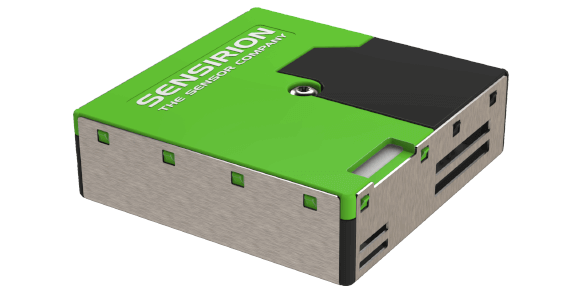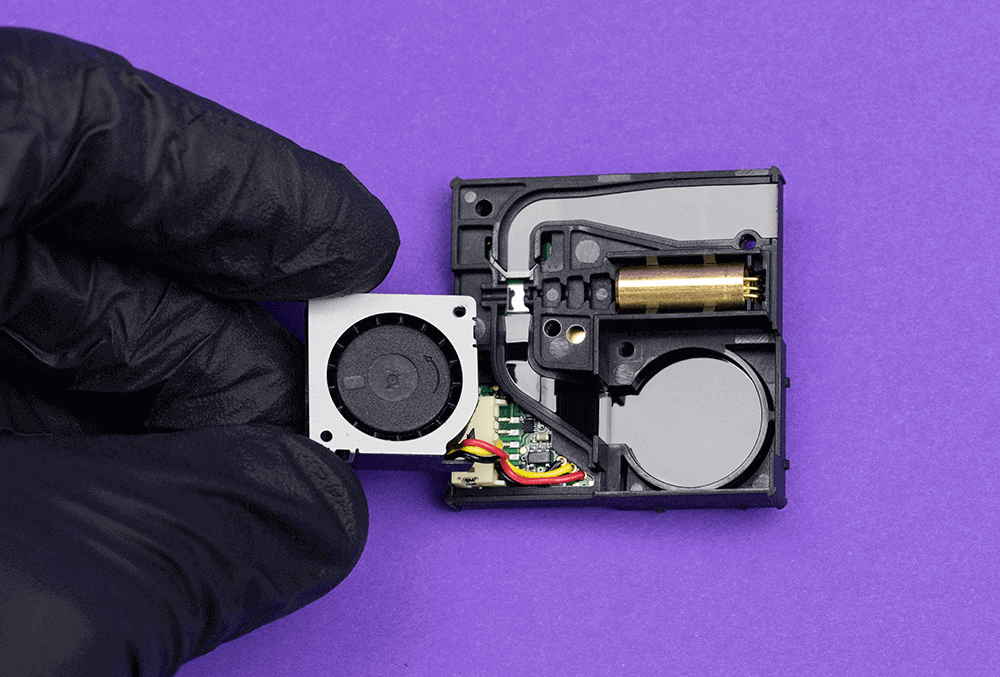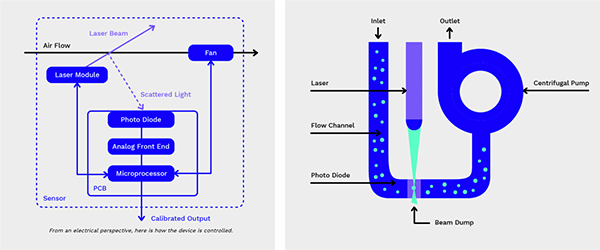In an unsponsored teardown, the MistyWest team had torn down a Sensirion SPS30 Particle Matter Sensor, an environmental product line of the sensor company. The use cases for this product line seems fairly face-value since it’s recommended for HVAC and air quality applications; however, this device is more than what I would normally consider “run of the mill” as we entered this unprecedented year of more than average, worldwide environmental effects such as the Australian brushfires back in early 2020 and how COVID-19 has currently been affecting pollution for better and for worse. As we push the boundaries of technology to address worldwise crises, it’s tools and introspection like what Steve Cooper, director of security, and his assistant, Angela May, mechanical design engineer for MistyWest, have done to provide information on the technology available for air quality innovation.
The breakdown went as follows:
The Outer Shell:
 The Sensirion SPS30
The Sensirion SPS30
The Coopers inspected 3 parts of the outer casing of the sensor: the aluminum sheet metal; the black, plastic enclosure and the HEPA filter (or the filter being housed under the green roof). Once you crack open these enclosures, the next layer that the MistyWest team found was an injection-molded inner-shell that held a PCB, the filter, and ultimately the optical particle sensor.
The “Science” of Particle Sensors:
Frankly, I probably would have glazed over this part of the teardown article since it’s not much of a breakdown of the device, but the breakdown of how the sensor works. However, MistyWest provided some nifty visuals that helped me understand Sensirion’s engineering.
First, Sensirion had to engineer a device that kept in-mind of air both entering and exiting to prevent turbulence/backflow back into the system. By engineering the encasement for laminar flow, this prevents dust particles from being stuck in corners of the unit and degrading the performance of the device over time.
 A small pocket underneath the fan acts as the inlet, and the air is pulled through to be exhausted through the van. Photo by Denis Godin
A small pocket underneath the fan acts as the inlet, and the air is pulled through to be exhausted through the van. Photo by Denis Godin
Second, like your mama used to always tell you: “Keep your photodiode clean.” By pulling the air through the fan and the HEPA filter, this thereby sheathes the air and can be better measured by the sensor’s laser light.
Lastly, Sensirion’s design of the laser had to pass through multiple baffles to reduce scatter and create a clean, focused beam to pass over the photodetector. The “beam dump”, as visualized in their diagrams, allows the light to scatter until it safely disperses, and the particles exit out through the centrifugal pump.
 The left-hand diagram depicts “the electrical perspective of how the device is controlled”; the right-hand diagram depicts how the air moves through the device and the multiple processes that occur.
The left-hand diagram depicts “the electrical perspective of how the device is controlled”; the right-hand diagram depicts how the air moves through the device and the multiple processes that occur.
To my understanding, the Particulate Matter Sensor SPS30 is MCERTS-Certified and is approved to be used in Europe, United Kingdom, and Canada. It’s this type of brilliant, engineering feats that make me a jealous American, but a hopeful Ioterran as we work together internationally with our partners, such as MistyWest, to address worldwide, environmental issues and ultimately, remedy them.
The breakdown went as follows:
The Outer Shell:
 The Sensirion SPS30
The Sensirion SPS30
The Coopers inspected 3 parts of the outer casing of the sensor: the aluminum sheet metal; the black, plastic enclosure and the HEPA filter (or the filter being housed under the green roof). Once you crack open these enclosures, the next layer that the MistyWest team found was an injection-molded inner-shell that held a PCB, the filter, and ultimately the optical particle sensor.
The “Science” of Particle Sensors:
Frankly, I probably would have glazed over this part of the teardown article since it’s not much of a breakdown of the device, but the breakdown of how the sensor works. However, MistyWest provided some nifty visuals that helped me understand Sensirion’s engineering.
First, Sensirion had to engineer a device that kept in-mind of air both entering and exiting to prevent turbulence/backflow back into the system. By engineering the encasement for laminar flow, this prevents dust particles from being stuck in corners of the unit and degrading the performance of the device over time.
 A small pocket underneath the fan acts as the inlet, and the air is pulled through to be exhausted through the van. Photo by Denis Godin
A small pocket underneath the fan acts as the inlet, and the air is pulled through to be exhausted through the van. Photo by Denis Godin
Second, like your mama used to always tell you: “Keep your photodiode clean.” By pulling the air through the fan and the HEPA filter, this thereby sheathes the air and can be better measured by the sensor’s laser light.
Lastly, Sensirion’s design of the laser had to pass through multiple baffles to reduce scatter and create a clean, focused beam to pass over the photodetector. The “beam dump”, as visualized in their diagrams, allows the light to scatter until it safely disperses, and the particles exit out through the centrifugal pump.
 The left-hand diagram depicts “the electrical perspective of how the device is controlled”; the right-hand diagram depicts how the air moves through the device and the multiple processes that occur.
The left-hand diagram depicts “the electrical perspective of how the device is controlled”; the right-hand diagram depicts how the air moves through the device and the multiple processes that occur.
To my understanding, the Particulate Matter Sensor SPS30 is MCERTS-Certified and is approved to be used in Europe, United Kingdom, and Canada. It’s this type of brilliant, engineering feats that make me a jealous American, but a hopeful Ioterran as we work together internationally with our partners, such as MistyWest, to address worldwide, environmental issues and ultimately, remedy them.

